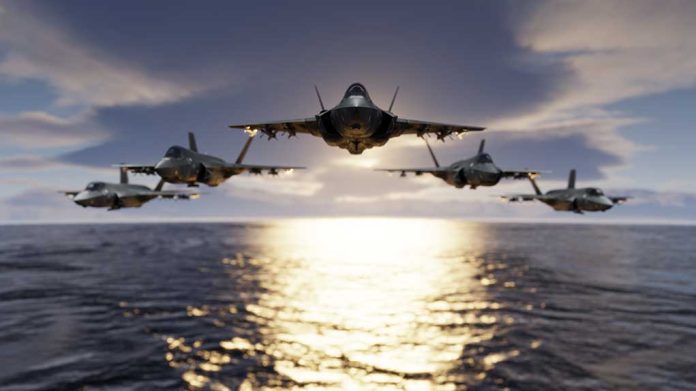
Ukrainian F-16 fighter jets have claimed their first Russian casualties, but at a steep cost as one jet was lost in combat after reportedly downing three Russian targets.
Key Takeaways
- Ukraine is now flying F-16 fighter jets received from NATO allies, significantly enhancing their defense capabilities against Russian forces
- Ukrainian F-16s are primarily being used in defensive roles to target Russian cruise missiles and drones rather than offensive operations
- Despite advanced capabilities, F-16s have suffered losses, including a recent incident and previous crashes that claimed the lives of Ukrainian pilots
- Ukraine requires substantial ongoing support in maintenance, parts, training, and munitions to fully utilize the F-16s’ potential against Russian threats
F-16s Enter Ukrainian Skies with Mixed Results
Ukraine’s air force has finally received the long-awaited F-16 fighter jets from NATO allies, marking a significant upgrade from their Soviet-era aircraft. These advanced fighters offer Ukrainian forces superior combat capabilities in engaging Russian aircraft, missiles, and drones. However, the jets’ arrival hasn’t dramatically altered the course of the conflict as many had hoped. Instead, the F-16s are primarily being deployed in defensive roles, protecting Ukrainian airspace rather than conducting offensive operations against Russian positions.
Despite their advanced capabilities, Ukrainian F-16s have already suffered losses. Recent reports indicate that contact was lost with one jet during combat operations, though Ukrainian sources claim it managed to down three Russian targets before being lost. This follows the earlier deaths of Ukrainian pilots Oleksii Mes and Pavlo Ivanov in separate F-16 incidents, highlighting the dangers faced by Ukraine’s newly trained fighter pilots as they adapt to Western aircraft amid intense combat conditions.
The Critical Need for Ongoing Support
The F-16s represent more than just hardware—they require a complete paradigm shift in Ukrainian air operations. Unlike the centralized command structure of Soviet military doctrine, F-16s operate best with decentralized decision-making, empowering pilots to make tactical choices. This transition demands not only technical training for pilots but a fundamental change in operational philosophy. Additionally, Ukraine desperately needs a comprehensive “lifecycle maintenance” package including parts, test equipment, and specialized tools to keep the jets operational in a high-intensity conflict environment.
“He’s playing with fire!” Said President Trump, referring to Russian President Putin’s escalation of attacks against Ukrainian infrastructure despite the introduction of Western aircraft.
The United States has approved a $310 million sale for F-16 modifications, upgrades, and support systems, while also providing non-operational F-16s for spare parts. However, Ukraine needs much more to maintain an effective air defense. Western countries transitioning to F-35s should consider providing surplus F-16 parts and equipment. Moreover, Ukrainian pilots require advanced electronic warfare self-protection pods to evade sophisticated Russian air defenses, as well as cost-effective air-to-air weapons systems optimized for intercepting missiles and drones.
Heroes in the Making
Despite the challenges, Ukrainian pilots have demonstrated remarkable courage in the transition to these Western fighters. The Ukrainian government has recognized their sacrifices, with fallen pilots receiving the nation’s highest honors. President Zelenskyy posthumously awarded the title of Hero of Ukraine to Pavlo Ivanov, acknowledging his supreme sacrifice in defense of his homeland. These pilots represent the vanguard of Ukraine’s effort to modernize its air force while under constant attack from Russian forces.
“For personal courage and heroism, demonstrated in the protection of the state sovereignty and territorial integrity of Ukraine, and selfless service to the Ukrainian people, I decree to award the title of Hero of Ukraine with the award of the ‘Golden Star’ order to Ivanov Pavlo Ivanovych,” Said President Volodymyr Zelenskyy
The training program for Ukrainian F-16 pilots continues to expand, with additional pilots receiving instruction in the United States and Europe. However, Ukraine faces a critical shortage in its pilot-to-aircraft ratio, necessitating more trained personnel to maintain continuous air operations. Swedish contributions of Saab 340 aircraft have improved Ukraine’s air domain awareness, but the country needs more comprehensive assistance to fully utilize its growing fleet of Western fighters against relentless Russian aerial attacks.
Too Little, Too Late?
Some Ukrainian officials have expressed frustration that the F-16s arrived too late to fundamentally alter the strategic balance. After more than two years of requesting these aircraft following Russia’s 2022 invasion, Ukraine finally began receiving them when Russian forces had already adapted their tactics. The ongoing Russian missile and drone attacks against Ukrainian cities demonstrate that despite the introduction of F-16s, the conflict remains at a deadly stalemate with civilians continuing to bear the brunt of the violence.
The introduction of F-16s represents a significant technological advancement for Ukraine’s air force, but their impact has been limited by timing, training constraints, and ongoing maintenance challenges. As Ukrainian pilots gain experience with these sophisticated aircraft, their effectiveness may improve, but the window of opportunity for these fighters to decisively influence the conflict’s outcome may have already narrowed considerably as Russian forces continue their relentless campaign against Ukrainian infrastructure and military positions.













